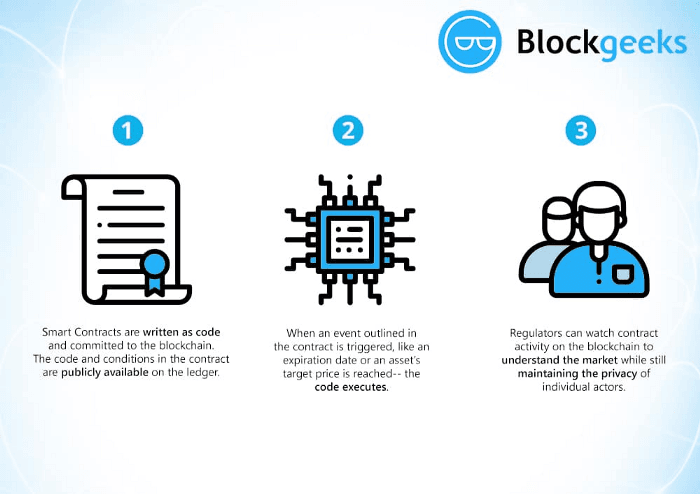Ethereum is the hugely popular open-source, blockchain-based, decentralized software platform with its own cryptocurrency, Ether, launched in 2015. It’s honestly a big deal, since it allows ‘smart contracts’ and Distributed Applications (Apps) to be designed and run without the possibility of downtime, fraud, control, or third-party intervention. A revolution, simply put.
Ethereum is unique. It is both a framework and a Turing-complete programming language that runs on a blockchain, allowing developers to create and publish distributed applications. Also, unlike Bitcoin and Litecoin, Ethereum’s supply isn’t set, and new Ethereum can be produced at any time.
Smart contracts — a key aspect of Ethereum — are intriguing because of the potential side effects they may have when conducting transactions, such as exchanging ether. What are the steps involved in creating and sending transactions to the Ethereum network?
The Ethereum blockchain
On Ethereum, all nodes (computers that help with validation) are connected. In addition to storing data, each Ethereum node follows the same set of rules for accepting transactions and running smart contracts.
In contrast to Bitcoin, Ethereum nodes store more than just transaction details. The network needs to keep track of the “state” — or the current information — of all of these applications, including each user’s balance, all the smart contract code, where it’s all stored, and any changes that are made.
These nodes are all linked together. Each Ethereum node, in addition to storing data, follows the same set of rules for accepting transactions and running smart contracts.
PoS on Ethereum
The proof-of-work algorithm, which was first introduced by Bitcoin, is what holds far-flung blockchain nodes in sync. It involves transaction verifiers called ‘miners’.
Miners are the actors who discourage bad conduct, such as making sure that no one spends their crypto balance more than once and try to game the system. They are rewarded for this in the form of more crypto — in this case, Ethereum. In the race to win more Ethereum when verifying transactions, miners expend thousands of dollars on machinery and energy.
Instead of any authority like PayPal or a bank, the aim is for the network of miners and nodes to take responsibility for shifting the shift from state to state. Ethereum miners verify the transfer of Ethereum ownership from one person to another. The Ethereum Virtual Machine (EVM — see above) executes a contract according to the rules programmed by the creator.
This entire model is called the Proof-of-Work model, where miners exhibit some sort of ‘work’ done to secure the system. Now, Proof-of-stake (PoS) is replacing proof-of-work as Ethereum’s consensus process (PoW). This was always the intention, as it’s an important part of the community’s plan to scale Ethereum through the Eth2 upgrades. However, having PoS right is a major technological challenge, and it’s not as easy as using PoW to achieve network consensus. PoS is part of the Ethereum 2 upgrade.
Functions of Smart Contracts on Ethereum
The primary difference between Ethereum and Bitcoin is functionality. Ethereum doesn’t move money — it can execute entire programs using smart contracts. How do they work?

Any public feature in Solidity (Ethereum’s programming language) that can change state can be invoked through a transaction. From the perspective of a programmer, the invocation needs three components:
- The contract’s address,
- The function to be invoked, and
- The values of the function’s arguments (if any).
It’s worth noting that functions and arguments aren’t mentioned directly in our description of a transaction. Since the Ethereum Virtual Machine has no concept of functions or arguments, this is the case. Instead, they are encoded into lower-level primitives for the EVM during the compilation process. The signature and arguments of the function are encoded in the transaction request’s “information.”
● Transactions are used in any operation that modifies the Ethereum blockchain.
● Smart contract transactions involve encoded data that identifies which function and arguments should be used (if any).
● A commitment to pay a limited amount of ether for gas can be included in a transaction, as well as a transfer of ether to the receiver.
● Only approved transactions are carried out thanks to the use of a nonce and a cryptographic signature.
Ethereum 2 Roadmap
Eth2 refers to a series of enhancements that will improve Ethereum’s scalability, security, and long-term viability. Multiple teams from around the Ethereum ecosystem are working on these updates.
Ethereum must be able to process more transactions per second without increasing the network’s node size. The Ethereum blockchain is stored and managed by nodes, which are important network participants. Increasing node size isn’t feasible because it would require powerful and costly computers. More transactions per second, as well as more nodes, are needed for Ethereum to scale. More nodes indicate greater protection.
A proposed shard chains update will divide the network’s load through 64 new chains. This will allow Ethereum to breathe easier by reducing congestion and rising transaction speeds beyond the current limit of 15–45 transactions per second.
And, despite the fact that there will be more chains, validators, which are the network’s maintainers — will have to do less work. Validators would just have to ‘run’ their own shard, not the entire Ethereum network. This makes Ethereum’s nodes lighter, allowing it to scale while staying decentralised.
The Eth2 enhancements strengthen Ethereum’s defences against concerted assaults, such as a 51% attack — a form of attack in which someone with a majority of the network can push fraudulent changes.
Because of the switch to proof-of-stake, the Ethereum protocol now has more disincentives for people to attack it.
As Blockchain and cryptocurrency enthusiasts, we at Giottus realize that the latest advances in this field are just the tip of the iceberg and that the true success of the technology is dependent on mass adoption. With Ethereum 2 shaping up the way it is, these are exciting times!
